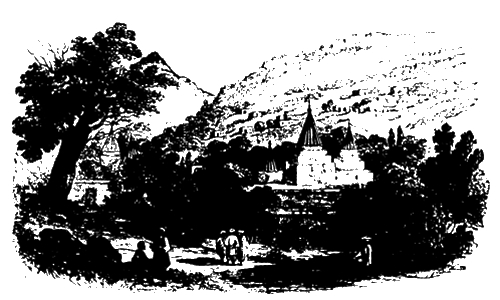Three figures from the yezidi folk pantheon
Victoria Arakelova

(Yerevan State University)
The Sun and the Moon (Sheykh Shams and Faxr ad-din)
Part 1
Sheykh Shams (Šēx Šams, Šēx Šims, Šēšims, Šēšim) and Faxr addin (Farxadīn, Faxradīn): deified historical personalities, brothers, the sons of ‘Adi II, who was the third to lead the Adawiyya community. Except for the fact that the former, Sheykh Shams, became the head of the community after his father’s death, we can hardly find any significant event in their real biographies. The tradition has preserved neither scriptures nor even any oral testaments attributed to them. Still, both informally canonised, they passed the limits of mere saints, and penetrated into the Yezidi folk pantheon, having become associated with the lords of the sun and the moon. Generally, the deification process, if it does not have a traceable genesis, as it does in the case of Sheykh Adi, for example, belongs to the most enigmatic, although widely represented, phenomena in many syncretic religious systems, and in Yezidism in particular. Sometimes it has nothing to do with the real contribution of the deified personage to the history of the religious movement, nor with his deeds, nor even with thaumaturgy.
The “required” mythological details hide a hero’s realistic characteristics and together with them the probable derivation of the process itself. All the more so in the doctrines deprived of a centralised religious institution, in which orthodoxy is completely left for the spiritual masters’ interpretation, and the orthopraxy’s fate entirely depends on the tradition preserved by spiritual castes. In such cases it is sometimes useless to search for the roots of phenomena, which are lost, as a rule, in the divagations of the early stages of a teaching’s formation.
The case with Sheykh Shams, however, does not seem to be so problematic: the secondary reference of his name with the sun– Šams ad-dīn (Šēx Šams–the personification of the sun (Šams– Arabic “the sun”)–determined his identification with the god of the Diurnal Star. Sheikh Shams is the third manifestation of Malak-•āwūs, corresponding to the Angel Israfil (Raphael). Although mainly the sun’s personification, Sheykh Shams is sometimes endowed with the characteristics of the Godhead: one of his epithets is bīnāyā ĉavā–“the eyes’ light”, which is a metaphor for God among the Yezidis. And sometimes he is identified with Isa (while ‘Īsā Jesus, is only nominally represented in the Yazidi liturgy).
Sheykh Shams is considered the wazīr of Sheykh ‘Adi, that is, his deputy, and the head of the Yazidi spiritual council (dīvān). Kreyenbroek’s suggestion that Sheykh Shams should be also regarded as the Lord of the Moon (although traditionally this is his brother Farxadin’s domain) seems to be unwarranted, as it is based on an erroneous interpretation of the hymn to which the author refers. The line Šēšimsē min xudānē māngā, translated as “My Sheikh Shams is the Lord of the Moon”, should be in fact interpreted as “My Sheikh Shams is the Lord of the Disc (Disc of the Sun)”.
The word māng in similar contexts, which mainly occur in religious hymns, has two meanings–“moon” and “disc, circle” (either that of the sun or of the moon; “moon” itself is hīv or hayv in Kurmanji).
See the following passage from the hymn to Sheykh.
Shams (Baytā Šēx Šims):
Wē kim, ro hiltēya,
Māngā zara p’ēya,
Šēx Šims divānbagē xwadēya.
I testify, the Sun has risen,
The golden disc [of course, that of the sun, not of the moon] has
ascended,
Sheykh Shams–the Head of God’s Council.
Or:
Rō hātiya a’ršāna,
Hilātiya māngā girāna,
Nūr, nadara
Šēx Šims dāya ma’sīyā binī ba’rāna
The Sun has ascended to the sky,
The heavy disc has risen,
The light [and] the look of Sheykh Shams penetrated [even]
to the fish under the sea.
Sheykh Shams is the essence of the Yezidi religion, as in Šēx Šims masabē mina–“Sheykh Shams is the essence [literally “confession, doctrine”] of my religion”, the light of the faith– ĉirā dīnī, qible–qibla, the power of the faith–qawatā dīn, the master of spiritual knowledge–xudanē ma’rīfatē ū ark’ān ū nāsīna, the owner of the seal–mōrā Šēx Šims, the torch of the Yezidi community–ĉirā bar sunatē and, the most important, God’s eye– ĉavē xwadē. The tradition attributed Sheykh Shams with the power over hell and the Sirāt bridge:
Wē kim, Rō hilāta,
Mizgīna walāta,
Daste Šēx Šims dāya p’ira dōža-salāta.
Wē kim, hiltē Rōža,
Šēxē nurī biškōža,
Dastē Šēx Šims dāya p’ira Salāt ū dōža.
I testify, the Sun has risen,
The good news to the world,
The bridge of hell–Sirat–is given into the hands of Sheykh
Shams.
I testify, the Sun is ascending,
Sheykh Shams is in the button,
The Sirat bridge and hell are given into the hands of Sheykh
Shams.
Yazidis.info
Tags:
Three figures from the yezidi folk pantheon
Victoria Arakelova

(Yerevan State University)
The Sun and the Moon (Sheykh Shams and Faxr ad-din)
Part 1
Sheykh Shams (Šēx Šams, Šēx Šims, Šēšims, Šēšim) and Faxr addin (Farxadīn, Faxradīn): deified historical personalities, brothers, the sons of ‘Adi II, who was the third to lead the Adawiyya community. Except for the fact that the former, Sheykh Shams, became the head of the community after his father’s death, we can hardly find any significant event in their real biographies. The tradition has preserved neither scriptures nor even any oral testaments attributed to them. Still, both informally canonised, they passed the limits of mere saints, and penetrated into the Yezidi folk pantheon, having become associated with the lords of the sun and the moon. Generally, the deification process, if it does not have a traceable genesis, as it does in the case of Sheykh Adi, for example, belongs to the most enigmatic, although widely represented, phenomena in many syncretic religious systems, and in Yezidism in particular. Sometimes it has nothing to do with the real contribution of the deified personage to the history of the religious movement, nor with his deeds, nor even with thaumaturgy.
The “required” mythological details hide a hero’s realistic characteristics and together with them the probable derivation of the process itself. All the more so in the doctrines deprived of a centralised religious institution, in which orthodoxy is completely left for the spiritual masters’ interpretation, and the orthopraxy’s fate entirely depends on the tradition preserved by spiritual castes. In such cases it is sometimes useless to search for the roots of phenomena, which are lost, as a rule, in the divagations of the early stages of a teaching’s formation.
The case with Sheykh Shams, however, does not seem to be so problematic: the secondary reference of his name with the sun– Šams ad-dīn (Šēx Šams–the personification of the sun (Šams– Arabic “the sun”)–determined his identification with the god of the Diurnal Star. Sheikh Shams is the third manifestation of Malak-•āwūs, corresponding to the Angel Israfil (Raphael). Although mainly the sun’s personification, Sheykh Shams is sometimes endowed with the characteristics of the Godhead: one of his epithets is bīnāyā ĉavā–“the eyes’ light”, which is a metaphor for God among the Yezidis. And sometimes he is identified with Isa (while ‘Īsā Jesus, is only nominally represented in the Yazidi liturgy).
Sheykh Shams is considered the wazīr of Sheykh ‘Adi, that is, his deputy, and the head of the Yazidi spiritual council (dīvān). Kreyenbroek’s suggestion that Sheykh Shams should be also regarded as the Lord of the Moon (although traditionally this is his brother Farxadin’s domain) seems to be unwarranted, as it is based on an erroneous interpretation of the hymn to which the author refers. The line Šēšimsē min xudānē māngā, translated as “My Sheikh Shams is the Lord of the Moon”, should be in fact interpreted as “My Sheikh Shams is the Lord of the Disc (Disc of the Sun)”.
The word māng in similar contexts, which mainly occur in religious hymns, has two meanings–“moon” and “disc, circle” (either that of the sun or of the moon; “moon” itself is hīv or hayv in Kurmanji).
See the following passage from the hymn to Sheykh.
Shams (Baytā Šēx Šims):
Wē kim, ro hiltēya,
Māngā zara p’ēya,
Šēx Šims divānbagē xwadēya.
I testify, the Sun has risen,
The golden disc [of course, that of the sun, not of the moon] has
ascended,
Sheykh Shams–the Head of God’s Council.
Or:
Rō hātiya a’ršāna,
Hilātiya māngā girāna,
Nūr, nadara
Šēx Šims dāya ma’sīyā binī ba’rāna
The Sun has ascended to the sky,
The heavy disc has risen,
The light [and] the look of Sheykh Shams penetrated [even]
to the fish under the sea.
Sheykh Shams is the essence of the Yezidi religion, as in Šēx Šims masabē mina–“Sheykh Shams is the essence [literally “confession, doctrine”] of my religion”, the light of the faith– ĉirā dīnī, qible–qibla, the power of the faith–qawatā dīn, the master of spiritual knowledge–xudanē ma’rīfatē ū ark’ān ū nāsīna, the owner of the seal–mōrā Šēx Šims, the torch of the Yezidi community–ĉirā bar sunatē and, the most important, God’s eye– ĉavē xwadē. The tradition attributed Sheykh Shams with the power over hell and the Sirāt bridge:
Wē kim, Rō hilāta,
Mizgīna walāta,
Daste Šēx Šims dāya p’ira dōža-salāta.
Wē kim, hiltē Rōža,
Šēxē nurī biškōža,
Dastē Šēx Šims dāya p’ira Salāt ū dōža.
I testify, the Sun has risen,
The good news to the world,
The bridge of hell–Sirat–is given into the hands of Sheykh
Shams.
I testify, the Sun is ascending,
Sheykh Shams is in the button,
The Sirat bridge and hell are given into the hands of Sheykh
Shams.
Yazidis.info
Tags:


























